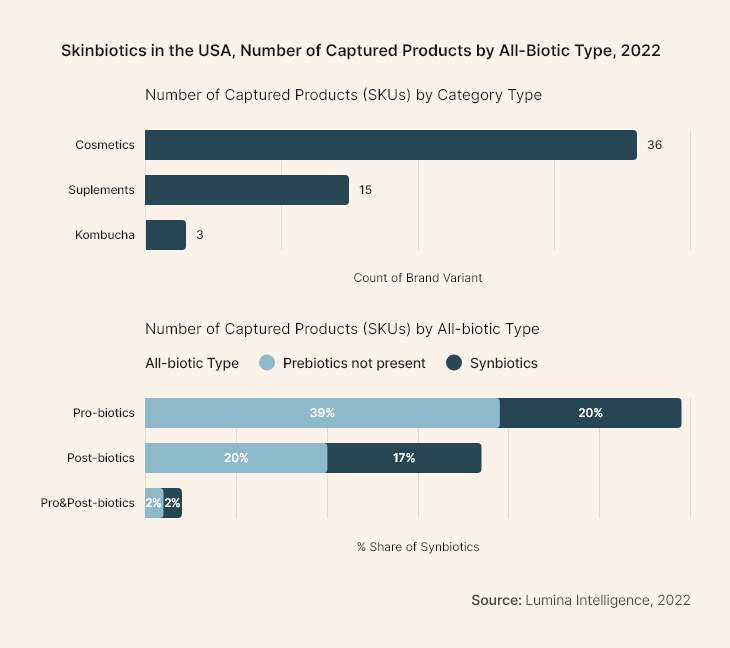
Our skin is not only the body’s largest organ – it is also the most visible and exposed bodily organ. And in this age of social media and selfies, consumers are more tuned in than ever to their appearances.
On the other hand, our skin is exposed to range of insults, from air pollution to allergens to sanitizing preparations, all of which impact the delicate balance of microorganisms who call our skin home.
Add into the mix increasing rates of skin conditions like eczema rates and skin allergies in developed and developing nations, and you have a situation where researchers, brands, consumers are waking up to the opportunity to impact the skin microbiome to improve skin health.
When thinking about the skin health, it’s important to differentiate between the approaches: Probiotic supplements are designed to improve skin health from within, with end points mostly focusing on eczema, skin allergies and intolerances. Probiotic cosmetics on the other hand are topical applications most frequently associated with skin hydration, anti-ageing, acne, spots and redness (rosacea).
We’re also seeing the emergence of prebiotics and postbiotics for skin health, although the latter is still very much in its infancy (as it is in general).
It’s also important to note that Postbiotic cosmetics might have gone ‘under the radar’ for the last 5 years, being commonly referred to as probiotics (probiotic cosmetics), or not referred to as pro/post at all. For example Tula Skincare offers “Probiotics and Superfoods” – a range of cosmetics, which list Bifida ferment lysate or Lactococcus ferment lysate as ingredients, each being a postbiotic by ISAPP’s definition.
Another example, Pacifica Coconut Probiotic Water Rehab Cream, which has been tracked by Lumina in Canada from 2017, contains the word “probiotic” in the product name, yet it contains lactococcus ferment lysate.
These market developments preceded ISAPP’s consensus definition of postbiotics. If one day all cosmetics that contain postbiotic ingredients got re-classified/renamed as postbiotics, Lumina predicts the numbers could catch some market observers by surprise.
Science
The boom in research into the gut microbiome has provided a path to explore the microbiome in other areas, including the skin. This has led to a surge in research into the skin microbiome and the possibility to modulate that microbiome to improve health. Interest has even extended to how space flights may impact the skin microbiome [1].
In an extensive 2023 review titled, The Skin Microbiome: Current Landscape and Future Opportunities, scientists from the University of Hull, UK, concluded: “Despite our limited understanding of the physiological role of skin microbiota in cutaneous biology, several strategies have been implemented to modulate the microbiome to improve health. This includes the use of antimicrobial products produced by bacteria to treat skin infection, and transplantation of commensal Gram-negative bacteria to ameliorate skin disease.
“Moreover, the use of probiotics and postbiotics shows promise in alleviating ageing pathology and accelerating wound repair in experimental models.” [2]
For example, a 2015 study by Korean researchers reported that orally ingested L. plantarum HY7714 (HY7714) was associated with improved skin hydration and anti-photoageing effects [3].
Other research areas include a new generation of emollients and moisturizers, some using bacterial lysates (postbiotics) derived from Vitreoscilla filiformis or Lactobacillus.
Looking at the US online market, Lumina Intelligence shows that the majority of skinbiotic products are positioned as cosmetics (36 topical products as of 2022), with 15 dietary supplement products making some form of skin health claims.
It is worth noting that many products are considered synbiotic and contain prebiotics.
Engagement in the US online space saw some big growth for a few notable brands in 2022, namely MaryRuth Organics, Love Wellness, and Tula.
Each brand has a different approach to the market: MaryRuth’s Skincare Probiotic Topical Spray is formulated with a “proprietary blend of seven probiotic strains”, according to the company’s website [4]. Love Wellness’ Clear Skin Probiotics are capsules formulated with Morinaga’s Bifidobacterium longum BB536 [5]. Tula’s 24-7 moisture hydrating day & night cream is formulated with “probiotic extracts” and prebiotic inulin [6].
Prebiotics
Zooming in on prebiotics, these have been attracting a lot of attention from some notable multinationals, such as Unilever, P&G, and Colgate-Palmolive, probably because of ease of formulation with the ingredients, particularly compared to sensitive probiotics. In addition, prebiotics will selectively enhance levels of beneficial bacteria already present on the skin.
Colgate-Palmolive has spent R&D dollars on butyloctanol, which it uses in its Sanex BiomeProtect range of deodorant products. The compound 2-butyloctanol is reported to have prebiotic activity by promoting skin-friendly bacteria in human armpits (Staphylococcus), while also inhibiting the growth of odor-causing Corynebacterium. [7]
P&G has filed patents relating to prebiotics (GOS) for a topical cosmetic composition containing a prebiotic agent which claims to improve the condition and appearance of the skin and the skin microbiome. [8]
Unilever also has prebiotic patents relating to cosmetic products (anti-dandruff shampoo), but the multinational has also worked with IBM to identify specific antimicrobial peptides (AMPs) to modulate the skin microbiome and reduce Staphylococcus aureus, an organism widely associated with skin infections. [9]
Outlook
It is still early days around the science of the skin microbiome and approaches to beneficially modulate it, but consumers are engaging with the brands, and much R&D money is focused on ingredient development and product formulation.
While many nutritional products act in subtle ways, the overall success of the nutricosmetics category depends on consumers feeling and, more importantly, seeing a difference. Seeing is believing…
References
[1] Tozzo et al., Life, 12(10):1498, (2022); doi: 10.3390/life12101498
[2] Smythe et al. Int. J. Mol. Sci., 24(4), 3950, (2023); doi: 10.3390/ijms24043950
[3] Lee et al, J. Microbiol. Biotechnol., 25(12), 2160-8, (2015); doi: 10.4014/jmb.1509.09021
[4] https://www.maryruthorganics.com/collections/children/products/skin-usda-organic-topical-probiotic-spray-vegan-non-gmo-4oz Accessed March 14, 2023
[5] https://lovewellness.com/products/clear-skin-probiotics Accessed March 14, 2023
[6] https://www.tula.com/products/hydrating-day-night-cream Accessed March 14, 2023
[7] Li et al. Int. J. Cosmet Sci, 43(6), 627-635, (2021), doi: 10.1111/ics.12738 Accessed March 14, 2023
[8] McDougall, CosmeticsDesign-USA, 2016, https://www.cosmeticsdesign.com/Article/2016/01/08/P-G-applies-for-patent-for-prebiotic-agent-containing-composition-targeting-skin-microbiome Accessed March 14, 2023
[9] Losasso et al. Biophysical Journal. 121, (3), 491-501, (2022), doi: 10.1016/j.bpj.2021.12.029
Skinbiotics: Probiotics for skin health, eczema, allergies & more
This report uncovers the impact of skin disorders and the role of Skinbiotics. Explore scientific findings on probiotics for skin health, eczema, allergies, and aging.


